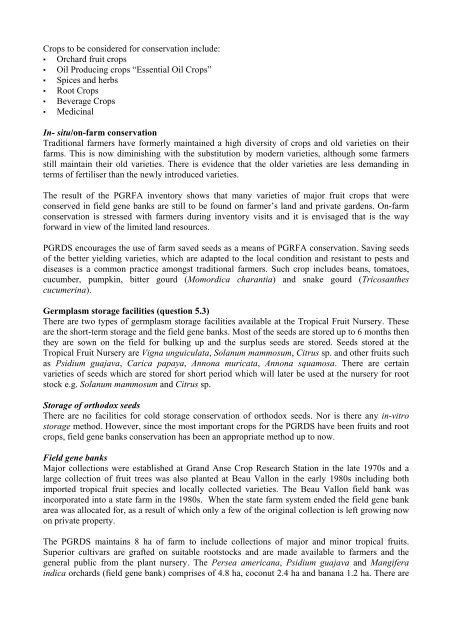Improving the identification, handling and storage of âdifficultâ seeds ...
Improving the identification, handling and storage of âdifficultâ seeds ...
Improving the identification, handling and storage of âdifficultâ seeds ...
You also want an ePaper? Increase the reach of your titles
YUMPU automatically turns print PDFs into web optimized ePapers that Google loves.
Crops to be considered for conservation include:<br />
▪ Orchard fruit crops<br />
▪ Oil Producing crops “Essential Oil Crops”<br />
▪ Spices <strong>and</strong> herbs<br />
▪ Root Crops<br />
▪ Beverage Crops<br />
▪ Medicinal<br />
In- situ/on-farm conservation<br />
Traditional farmers have formerly maintained a high diversity <strong>of</strong> crops <strong>and</strong> old varieties on <strong>the</strong>ir<br />
farms. This is now diminishing with <strong>the</strong> substitution by modern varieties, although some farmers<br />
still maintain <strong>the</strong>ir old varieties. There is evidence that <strong>the</strong> older varieties are less dem<strong>and</strong>ing in<br />
terms <strong>of</strong> fertiliser than <strong>the</strong> newly introduced varieties.<br />
The result <strong>of</strong> <strong>the</strong> PGRFA inventory shows that many varieties <strong>of</strong> major fruit crops that were<br />
conserved in field gene banks are still to be found on farmer’s l<strong>and</strong> <strong>and</strong> private gardens. On-farm<br />
conservation is stressed with farmers during inventory visits <strong>and</strong> it is envisaged that is <strong>the</strong> way<br />
forward in view <strong>of</strong> <strong>the</strong> limited l<strong>and</strong> resources.<br />
PGRDS encourages <strong>the</strong> use <strong>of</strong> farm saved <strong>seeds</strong> as a means <strong>of</strong> PGRFA conservation. Saving <strong>seeds</strong><br />
<strong>of</strong> <strong>the</strong> better yielding varieties, which are adapted to <strong>the</strong> local condition <strong>and</strong> resistant to pests <strong>and</strong><br />
diseases is a common practice amongst traditional farmers. Such crop includes beans, tomatoes,<br />
cucumber, pumpkin, bitter gourd (Momordica charantia) <strong>and</strong> snake gourd (Tricosan<strong>the</strong>s<br />
cucumerina).<br />
Germplasm <strong>storage</strong> facilities (question 5.3)<br />
There are two types <strong>of</strong> germplasm <strong>storage</strong> facilities available at <strong>the</strong> Tropical Fruit Nursery. These<br />
are <strong>the</strong> short-term <strong>storage</strong> <strong>and</strong> <strong>the</strong> field gene banks. Most <strong>of</strong> <strong>the</strong> <strong>seeds</strong> are stored up to 6 months <strong>the</strong>n<br />
<strong>the</strong>y are sown on <strong>the</strong> field for bulking up <strong>and</strong> <strong>the</strong> surplus <strong>seeds</strong> are stored. Seeds stored at <strong>the</strong><br />
Tropical Fruit Nursery are Vigna unguiculata, Solanum mammosum, Citrus sp. <strong>and</strong> o<strong>the</strong>r fruits such<br />
as Psidium guajava, Carica papaya, Annona muricata, Annona squamosa. There are certain<br />
varieties <strong>of</strong> <strong>seeds</strong> which are stored for short period which will later be used at <strong>the</strong> nursery for root<br />
stock e.g. Solanum mammosum <strong>and</strong> Citrus sp.<br />
Storage <strong>of</strong> orthodox <strong>seeds</strong><br />
There are no facilities for cold <strong>storage</strong> conservation <strong>of</strong> orthodox <strong>seeds</strong>. Nor is <strong>the</strong>re any in-vitro<br />
<strong>storage</strong> method. However, since <strong>the</strong> most important crops for <strong>the</strong> PGRDS have been fruits <strong>and</strong> root<br />
crops, field gene banks conservation has been an appropriate method up to now.<br />
Field gene banks<br />
Major collections were established at Gr<strong>and</strong> Anse Crop Research Station in <strong>the</strong> late 1970s <strong>and</strong> a<br />
large collection <strong>of</strong> fruit trees was also planted at Beau Vallon in <strong>the</strong> early 1980s including both<br />
imported tropical fruit species <strong>and</strong> locally collected varieties. The Beau Vallon field bank was<br />
incorporated into a state farm in <strong>the</strong> 1980s. When <strong>the</strong> state farm system ended <strong>the</strong> field gene bank<br />
area was allocated for, as a result <strong>of</strong> which only a few <strong>of</strong> <strong>the</strong> original collection is left growing now<br />
on private property.<br />
The PGRDS maintains 8 ha <strong>of</strong> farm to include collections <strong>of</strong> major <strong>and</strong> minor tropical fruits.<br />
Superior cultivars are grafted on suitable rootstocks <strong>and</strong> are made available to farmers <strong>and</strong> <strong>the</strong><br />
general public from <strong>the</strong> plant nursery. The Persea americana, Psidium guajava <strong>and</strong> Mangifera<br />
indica orchards (field gene bank) comprises <strong>of</strong> 4.8 ha, coconut 2.4 ha <strong>and</strong> banana 1.2 ha. There are

















